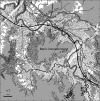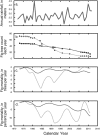Land use history and population dynamics of free-standing figs in a maturing forest
- PMID: 28542161
- PMCID: PMC5443483
- DOI: 10.1371/journal.pone.0177060
Land use history and population dynamics of free-standing figs in a maturing forest
Abstract
Figs (Ficus sp.) are often considered as keystone resources which strongly influence tropical forest ecosystems. We used long-term tree-census data to track the population dynamics of two abundant free-standing fig species, Ficus insipida and F. yoponensis, on Barro Colorado Island (BCI), a 15.6-km2 island in Lake Gatún, Panama. Vegetation cover on BCI consists of a mosaic of old growth (>400 years) and maturing (about 90-150 year old) secondary rainforest. Locations and conditions of fig trees have been mapped and monitored on BCI for more than 35 years (1973-2011), with a focus on the Lutz Catchment area (25 ha). The original distribution of the fig trees shortly after the construction of the Panama Canal was derived from an aerial photograph from 1927 and was compared with previous land use and forest status. The distribution of both fig species (~850 trees) is restricted to secondary forest. Of the original 119 trees observed in Lutz Catchment in 1973, >70% of F. insipida and >90% of F. yoponensis had died by 2011. Observations in other areas on BCI support the trend of declining free-standing figs. We interpret the decline of these figs on BCI as a natural process within a maturing tropical lowland forest. Senescence of the fig trees appears to have been accelerated by severe droughts such as the strong El Niño event in the year 1982/83. Because figs form such an important food resource for frugivores, this shift in resource availability is likely to have cascading effects on frugivore populations.
Conflict of interest statement
Figures




References
-
- Guariguata MR, Ostertag R. Neotropical secondary forest succession: changes in structural and functional characteristics. Forest Ecol Manag. 2001;148: 185–206.
-
- Chazdon RL. Beyond deforestation: restoring forests and ecosystem services on degraded lands. Science. 2008;320: 1458–1460. doi: 10.1126/science.1155365 - DOI - PubMed
-
- Chazdon RL, Peres CA, Dent D, Sheil D, Lugo AE, Lamb D, et al. The potential for species conservation in tropical secondary forests. Conserv Biol. 2009;23: 1406–1417. doi: 10.1111/j.1523-1739.2009.01338.x - DOI - PubMed
-
- Foster RB. Long-term change in the successional forest community of the Rio Manu floodplain In: Gentry AH, editor. Four Neotropical forests. New Haven: Yale University Press; 1990. pp. 565–572.
-
- Dunn RE. Recovery of faunal communities during tropical forest regeneration. Conserv Biol. 2004;18: 302–309.
MeSH terms
LinkOut - more resources
Full Text Sources
Other Literature Sources

